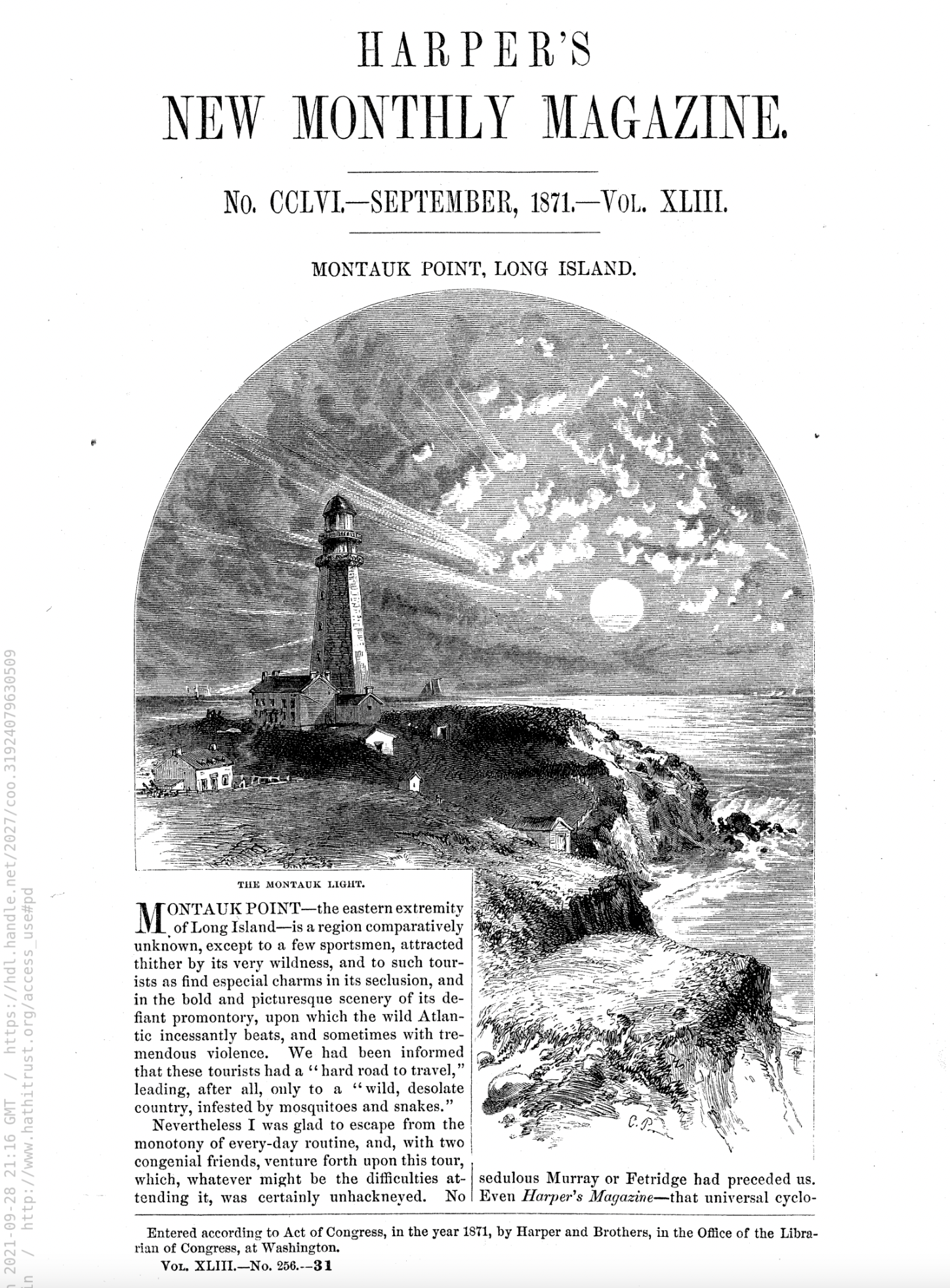“Montauk Point, Long Island,” by Charles Parsons. Article printed in Harper’s New Monthly Magazine, September 1871.
First page of article, showing woodcut illustration of the Montauk Lighthouse, Al Holden Collection, Montauk Library Archives.
Please note: This article is in the public domain, and can be accessed for free. See web address below.
This September marks the 150th anniversary of the publication by Harper’s New Monthly Magazine of the captivating and important travel piece titled “Montauk Point, Long Island,” written by Charles Parsons. The author and two “congenial friends” set off from Brooklyn on the steamer Eastern City in October 1869 to explore New York’s “easternmost extremity.” They disembarked in Sag Harbor, climbed into a coach for the journey south to East Hampton, and began their trek to Montauk almost immediately, walking eastward toward a supposed “wild, desolate country, infested by mosquitoes and snakes.” They chose the oceanfront as their highway, moving across the “sometimes impassable” and “dreaded” Napeague, with its “dreary” trees and shrubs, making slow passage as the high tide broke up their sandy trajectory. The landscape slowly worked its magic, however, and ultimately, they were bewitched.
Stopping often to pull out sketchbooks, they furiously described with pencil in hand an emerald crest of wave or sandpiper flitting across the beach. Within three days they would visit all three houses — First, Second, and Third — and finally reach the Lighthouse.
“Steadfast, serene, immovable, the same
Year after year, through all the silent night
Burns on forevermore that quenchless flame,
Shines on that inextinguishable light!”
Parsons incorporated 19th-century poetry throughout this piece, like the excerpt from Henry Wadsworth Longfellow’s The Lighthouse, above. Snippets of verse from Elizabeth Barrett Browning, Whitman, John Keats, and Whittier conveyed in powerful ways the author’s experience of colors and sounds, but Parsons’ own prose is descriptive and concise, often lyrical and even incandescent, such as this description of the friends’ approach to Second House: “After dinner we continued our walk, following the coast till sundown; then on over the downs, through time deepening twilight into the gloaming, the music of the everlasting and monotonous roar of the sea sounding in our ears, until we reached Mr. Osborne’s, near the beach, after dark.”
Harper’s New Monthly Magazine, begun in 1850, was published in New York City but had a global reach. One of America’s most popular magazines, it was a literary periodical that was known, also, for its travel pieces. Parsons alludes to that fact in this article, asking how Montauk had escaped the study of other travel writers. “Harper’s Magazine, that universal cyclopedia of travel, discovery, and adventure, which had explored the most secret recesses of Africa, [and] arctic mysteries … had, by a sort of telescopic instinct, overlooked this brave little headland right under its nose.”
Parsons introduced his readers to many characters and characteristics of Montauk, such as earmarks, the “inexplicable hieroglyphs” that identified, by owner, the cattle encountered on the bluffs, and the evidence of shipwrecks that scored the beaches. The Osbornes, who ran Second House, sat their guests around a cozy fire and regaled them with shipwreck stories so fearsomely graphic that “these pictures were not easily effaced from our minds.” In fact, a sketch of a shipwreck that had occurred a few years earlier, possibly of the John Milton that wrecked in 1858, was transferred to woodcut by Harper’s to illustrate this article.
The travelers reached the Lighthouse on their last full day, climbed the tower stairs, and received a good description of the Fresnel lens from the lighthouse keeper. After dark, Parsons stood on the Lighthouse platform, inhaling the Atlantic air and views of Connecticut and Rhode Island. “Out on the balcony that surrounded the tower, the glorious panorama of the moonlit sea lay all about us, and at that moment two ships were crossing the glinting light of the moon.” The author and his friends had done well, and the next morning they left Montauk, by horse and wagon this time, marveling at the autumn scenery as they traveled west.
Parsons’ article is wonderfully informative, like good guidebook writing should be, but it is also a thought-provoking and moving account of a journey that transformed its visitors. This is how the author ended his piece: “It had been the fortune of some of our party to visit the coasts of Italy, to wander over the downs on the Isle of Wight, to ramble on the heathery hills of Scotland, and to visit Newport, Nahant, Cape Ann, and Long Branch; but the two days’ tramp along the beach, and the ride over the downs of Montauk on that memorable October day, stand in strong relief above all other similar experiences.”
For many years following the publication of “Montauk Point, Long Island,” First House, Second House, and Third House were overwhelmed with visitors.


Reply or Comment